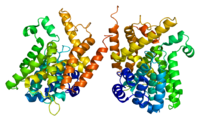
Photo from wikipedia
Phosphodiesterase (PDE4) is the predominantly expressing family of PDE enzyme in immune and inflammatory cells. Inhibition of PDE4 has been reported to suppress a diverse spectrum of inflammatory responses both… Click to show full abstract
Phosphodiesterase (PDE4) is the predominantly expressing family of PDE enzyme in immune and inflammatory cells. Inhibition of PDE4 has been reported to suppress a diverse spectrum of inflammatory responses both in vitro and in vivo. Many PDE4 inhibitors in development are shown to be efficacious in animal models of various inflammatory disorders, such as asthma, COPD, psoriasis, inflammatory bowel diseases, and rheumatoid arthritis, as well as in clinical trials for asthma and COPD. Therefore, PDE4 might prove as potential therapeutic targets in inflammatory and autoimmune diseases. The PDE4 enzyme family consists of four members (named PDE4A, PDE4B, PDE4C, and PDE4D) that are highly expressed in neutrophils, monocytes, central nervous system, and smooth muscles of the lung. Non-selective PDE4 inhibitors like Rolipram are associated with severe side effects like nausea and emesis. Second-generation PDE4 inhibitors like Roflumilast are reported with improved side effects, but narrow therapeutic window. The behavioral correlation of emesis in mice by deleting PDE4D encoding gene confirmed that inhibition of PDE4D, but not PDE4B is responsible for emetic effect of non-selective PDE inhibitors (Jin, Ding, & Lin, 2012). Therefore, selective PDE4B inhibitors can provide anti-inflammatory efficacy without any side effect. However, conserved active site residues of PDE4B and PDE4D make it difficult to design selective PDE4B inhibitors. In the line of identifying selective PDE4B inhibitors, a combined receptorand ligand-based approach can improve the binding affinity and selectivity of PDE4B inhibition. Thirty-four PDE4B structures are available in RCSB-PDB. Hitherto, no structural classification of available co-crystallized PDE4B inhibitors is reported. An in-depth analysis of available PDE4B-inhibitor complexes may help to find empirical parameters for selective enzyme inhibition. Chen et al. (2010) developed multiple pharmacophore models based on the 18 crystal structures of phosphodiesterase 4 (PDE4) with co-crystal ligand for discovering potential PDE4 inhibitors. Srivani, Usharani, Jemmis, and Sastry (2008) performed the crystal structure analysis of PDE4B and PDE4D which led to find significant variations in the M-loop region, which is the integral part of the active site of PDE4B and PDE4D. Ke (2004) performed the similar crystal structure analysis for PDE4 and PDE5 with respect to the metal binding site. In present study, first we retrieved the information from available PDE4B crystal structures and grouped the crystal ligands in different classes based on chemical scaffolds. We have employed structure and ligand-based dual approach for identifying potential and selective molecules for PDE4B. Structure-based approach presents advantage over ligand-based approach by incorporating spatial distribution of hotspot. At the same time ligandbased approach helps to identify key pharmacophoric features in ligands essential for bioactivity. We combined the chemical features of reported crystal ligands of PDE4B in RCSB PDB data bank and developed ligandbased pharmacophores. Using these queries, SPECS database of commercially available small molecules was screened to find new PDE4B inhibitors. To predict the selectivity in PDE4B over PDE4D, the screened molecules were docked in PDE4B (PDB ID: 3G45) and PDE4D (PDB ID: 3G4G) crystal structures using Glide. The stability of top-scoring ligand in PDE4B active site was confirmed by a 10 ns MD simulations (Figure 1). Our results provided critical insight for designing selective PDE4B inhibitors. This work is organized as follows. The crystal structure analysis, pharmacophore modeling, virtual screening (VS), docking and ADME studies, MD simulation materials, and reproducible methods are provided in next section. Further part includes is the analysis and discussion of crystal structure analysis and pharmacophore
Journal Title: Journal of Biomolecular Structure and Dynamics
Year Published: 2017
Link to full text (if available)
Share on Social Media: Sign Up to like & get
recommendations!